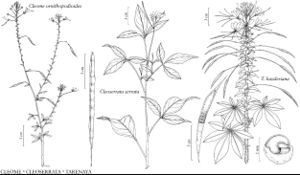Cleome
Sp. Pl. 2: 671. 1753.
Gen. Pl. ed. 5, 302. 1754.
| Taxon | Illustrator ⠉ | |
|---|---|---|
 | Cleome ornithopodioides Cleoserrata serrata Tarenaya hassleriana | Yevonn Wilson-Ramsey Yevonn Wilson-Ramsey Yevonn Wilson-Ramsey |
Herbs, annual or perennial. Stems unbranched or sparsely branched; glandular-pubescent, glabrous, glabrescent, or scabrous. Leaves: stipules absent or scalelike; petiole with pulvinus basally or distally, (petiolule basally adnate, forming pulvinar disc); leaflets 1 or 3 [–11] (flat). Inflorescences terminal or axillary (from distal leaves), racemes (flat-topped or elongated); bracts present [absent]. Flowers zygomorphic; sepals persistent, basally connate (1/2 of length), equal (each often subtending a nectary); petals equal; stamens [4] 6; filaments inserted on a discoid or conical androgynophore, glabrous; anthers (oblong to linear), coiling as pollen released; gynophore recurved in fruit [obsolete]. Fruits capsules, dehiscent, oblong. Seeds 4–25, reniform or ovoid-spheroidal, arillate or not, (cleft fused between ends). x = 10 (?).
Distribution
Introduced; Old World, warm temperate and tropical areas
Discussion
Species ca. 20 (2 in the flora).
The center of diversity of Cleome is in southwestern Asia. There are only two true Cleome in North America. Other native and adventive species formerly included in Cleome are placed in Arivela, Cleoserrata, Gynandropsis, Hemiscola, Peritoma, and Tarenaya.
Selected References
None.
Lower Taxa
Key
| 1 | Capsules 25-35 mm; bracts mostly unifoliate; leaflet blade linear to elliptic. | Cleome ornithopodioides |
| 1 | Capsules 40-70 mm; bracts trifoliate; leaflet blade oblanceolate to rhombic-elliptic. | Cleome rutidosperma |